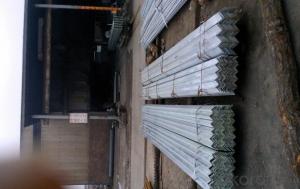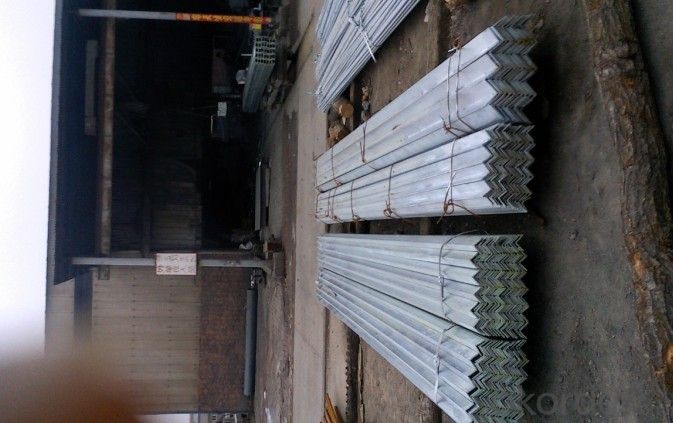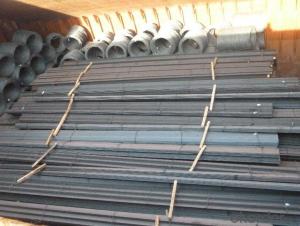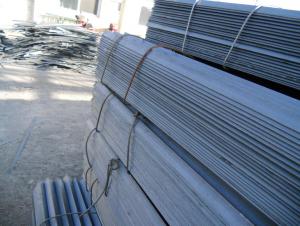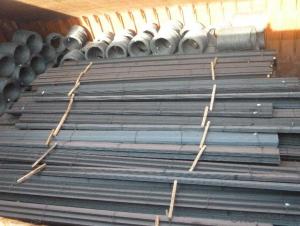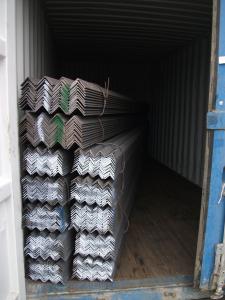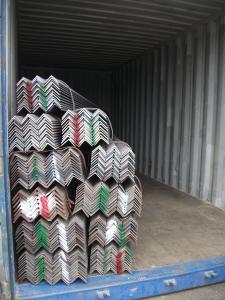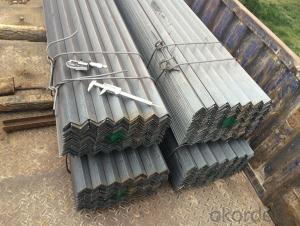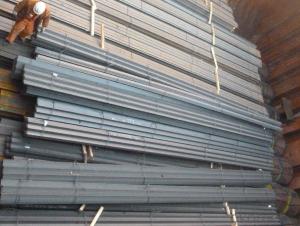HR Equal Angle Steel Bars for Warehouses
- Loading Port:
- Tianjin
- Payment Terms:
- TT OR LC
- Min Order Qty:
- 25 m.t.
- Supply Capability:
- 200000 m.t./month
OKorder Service Pledge
OKorder Financial Service
You Might Also Like
Product Description:
OKorder is offering HR Equal Angle Steel Bars for Warehouses at great prices with worldwide shipping. Our supplier is a world-class manufacturer of steel, with our products utilized the world over. OKorder annually supplies products to European, North American and Asian markets. We provide quotations within 24 hours of receiving an inquiry and guarantee competitive prices.
Product Applications:
HR Equal Angle Steel Bars for Warehouses are ideal for structural applications and are widely used in the construction of buildings and bridges, and the manufacturing, petrochemical, and transportation industries.
1. Supporting members, most commonly in the house raising industry to strengthen timber bears under houses. Transmission line towers, etc
2. Prefabricated structure
3. Medium scale bridges
4. It is widely used in various building structures and engineering structures such as roof beams, bridges, transmission towers, hoisting machinery and transport machinery, ships, industrial furnaces, reaction tower, container frame and warehouse etc.
Product Advantages:
HR Equal Angle Steel Bars for Warehouses are durable, strong, and resist corrosion.
Main Product Features:
· Premium quality
· Prompt delivery & seaworthy packing (30 days after receiving deposit)
· Corrosion resistance
· Can be recycled and reused
· Mill test certification
· Professional Service
· Competitive pricing
Product Specifications:
.Standards:GB,ASTM,BS,AISI,DIN,JIS
2.Invoicing on theoretical weight or actual weight as customer request
3.Material: JIS G3192,SS400;SS540.
4.Sizes:
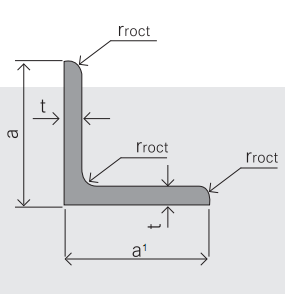
EQUAL ANGLES SIZES | |||
a(mm) | a1(mm) | thickness(mm) | length |
25 | 25 | 2.5---3.0 | 6M/12M |
30 | 30 | 2.5---4.0 | 6M/12M |
38 | 38 | 2.5 | 6M/12M |
38 | 38 | 3.0---5.0 | 6M/12M |
40 | 40 | 3.0---6.0 | 6M/12M |
50 | 50 | 3 | 6M/12M |
50 | 50 | 3.7---6.0 | 6M/9M/12M |
60 | 60 | 5.0---6.0 | 6M/9M/12M |
63 | 63 | 6.0---8.0 | 6M/9M/12M |
65 | 65 | 5.0---8.0 | 6M/9M/12M |
70 | 70 | 6.0---7.0 | 6M/9M/12M |
75 | 75 | 5.0---10.0 | 6M/9M/12M |
80 | 80 | 6.0---10.0 | 6M/9M/12M |
90 | 90 | 6.0---10.0 | 6M/9M/12M |
100 | 100 | 6.0---12.0 | 6M/9M/12M |
120 | 120 | 8.0-12.0 | 6M/9M/12M |
125 | 125 | 8.0---12.0 | 6M/9M/12M |
130 | 130 | 9.0-12.0 | 6M/9M/12M |
140 | 140 | 10.0-16.0 | 6M/9M/12M |
150 | 150 | 10---15 | 6M/9M/12M |
160 | 160 | 10---16 | 6M/9M/12M |
180 | 180 | 12---18 | 6M/9M/12M |
200 | 200 | 14---20 | 6M/9M/12M |
5. Material Specifications:
Grade | Yield Strength,N/mm² | Extension Strength N/mm² | |||
Thickness of Steel,mm | |||||
≦16 | >16-≦40 | >40-≦100 | >100 | ||
SS330 | ≧205 | ≧195 | ≧175 | ≧165 | 330-430 |
SS400 | ≧245 | ≧235 | ≧215 | ≧205 | 400-510 |
SS490 | ≧285 | ≧275 | ≧255 | ≧245 | 490-610 |
SS540 | ≧400 | ≧390 | - | - | ≧540 |
FAQ:
Q1: Why buy HR Equal Angle Steel Bars for Warehouses from OKorder.com?
A1: All products offered byOKorder.com are carefully selected from China's most reliable manufacturing enterprises. Through its ISO certifications, OKorder.com adheres to the highest standards and a commitment to supply chain safety and customer satisfaction.
Q2: What makes HR Equal Angle Steel Bars for Warehouses?
A2: Steel billets of high quality produced by big factories
Q3: Can HR Equal Angle Steel Bars for Warehouses rust?
A3: Stainless does not "rust" as you think of regular steel rusting with a red oxide on the surface that flakes off. If you see red rust it is probably due to some iron particles that have contaminated the surface of the stainless steel and it is these iron particles that are rusting. Look at the source of the rusting and see if you can remove it from the surface.
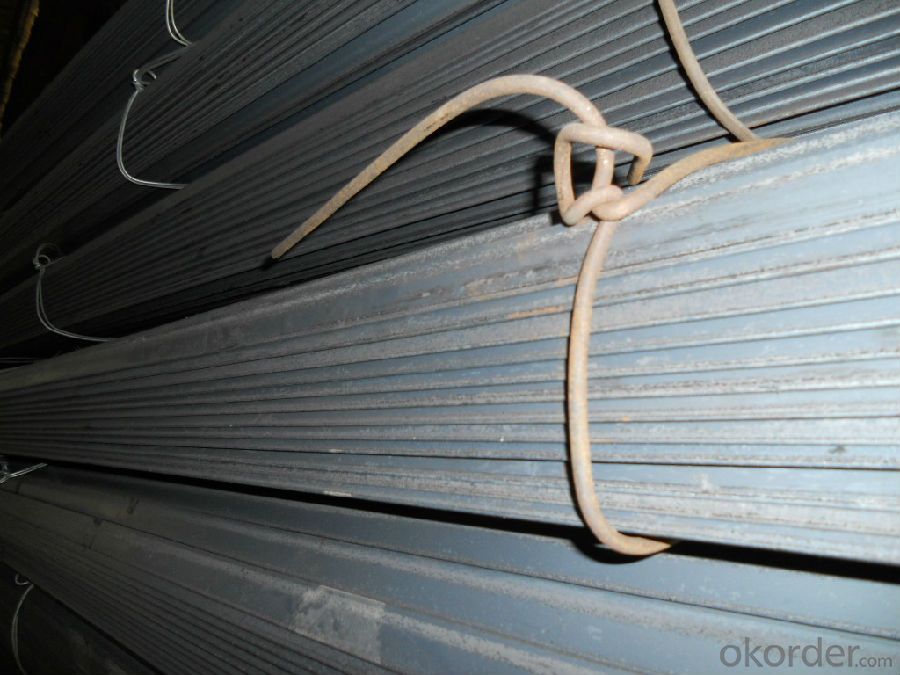
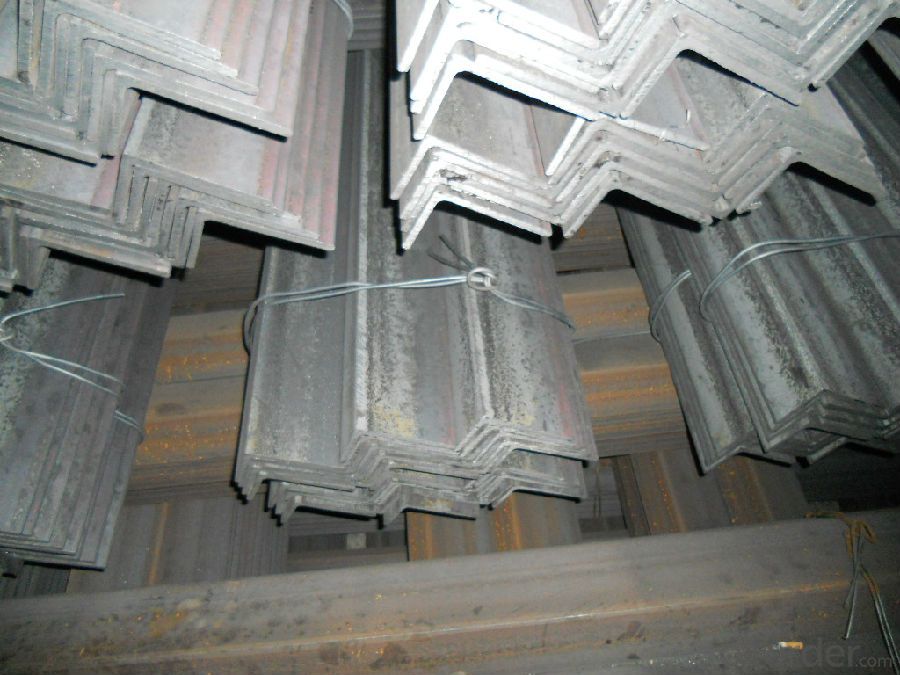
- Q: What is the typical shear strength of steel angles?
- The typical shear strength of steel angles can vary depending on the specific grade and dimensions of the angle. However, a general range for the shear strength of steel angles is typically between 50,000 to 75,000 pounds per square inch (psi).
- Q: Can steel angles be used as supports for suspended acoustical ceilings?
- Steel angles have the capacity to function as supports for suspended acoustical ceilings. They are frequently employed as a primary structural element in suspended ceiling systems, serving to establish stability and provide support for the acoustical ceiling tiles. Additionally, they aid in evenly distributing the weight across the ceiling grid. To ensure the secure installation and optimal sound absorption, the steel angles are typically placed at regular intervals along the ceiling's perimeter and connected to the main suspension system. The utilization of steel angles guarantees that the acoustical ceiling remains firmly in position while effectively enhancing the acoustic qualities of the area.
- Q: How do steel angles perform under cyclic loading?
- Due to their exceptional strength and stiffness properties, steel angles find wide usage in various structural applications. They perform exceptionally well under cyclic loading, which involves repeated loading and unloading cycles. When subjected to cyclic loading, steel angles exhibit fatigue, a phenomenon characterized by progressive and localized structural damage resulting from repeated loading and unloading. However, steel angles possess a high fatigue resistance, making them highly suitable for applications where cyclic loading is expected. The material properties of steel angles are the key factor contributing to their performance under cyclic loading. Steel, being a ductile and resilient material, can deform and absorb energy under cyclic loading. This prevents the accumulation of stress concentrations that could lead to failure. Furthermore, steel angles are typically designed with a sufficient factor of safety to withstand cyclic loading without compromising their structural integrity. This ensures that they can endure numerous cycles of loading and unloading without experiencing significant deformation or failure. In addition to their material properties, the structural design and fabrication of steel angles also play a crucial role in their performance under cyclic loading. Proper design, including considerations of expected loading conditions and appropriate reinforcement, ensures that steel angles can withstand cyclic loading without excessive deformation or stress concentrations. Overall, steel angles are well-suited for applications involving cyclic loading due to their high fatigue resistance, ductility, and structural design considerations. Their ability to withstand repeated loading and unloading cycles makes them a reliable and durable choice in various structural systems.
- Q: Can steel angles be used for shelving and storage racks?
- Indeed, shelving and storage racks can utilize steel angles. Given their robustness and endurance, steel angles are widely employed in construction and engineering. They offer exceptional structural reinforcement and are capable of withstanding substantial loads, making them a perfect fit for shelving and storage racks. By virtue of their easy fabrication and weldability, steel angles can be effortlessly joined together to create desired designs for shelving or storage racks. Moreover, they come in various dimensions and thicknesses, allowing for customization to meet specific storage requirements. Furthermore, steel angles exhibit resistance against corrosion, making them highly advantageous in environments where moisture or chemicals are prevalent. All in all, steel angles are a reliable and versatile option when it comes to shelving and storage racks.
- Q: How do you determine the load capacity of a steel angle?
- The load capacity of a steel angle is determined by calculating its moment of inertia and considering factors such as material strength, dimensions, and the type of loading it will be subjected to. Additionally, engineering standards and codes provide guidelines for determining load capacities based on these calculations.
- Q: What are the common methods of surface preparation for steel angles?
- Steel angles can be prepared for surface treatment through various methods, including grinding, sandblasting, and chemical cleaning. Grinding is a mechanical technique that involves using an abrasive wheel or disc to smooth and level the surface of the steel angle. This method effectively eliminates rust, scale, and other imperfections. It is commonly used for small-scale projects or when achieving a smooth surface finish is not crucial. Sandblasting, also referred to as abrasive blasting, entails propelling small particles onto the surface of the steel angle at high speeds. This method is highly efficient in removing mill scale, rust, paint, and other contaminants. Sandblasting creates a textured surface that enhances the adhesion of coatings or paints. It is often employed in large-scale industrial projects that require a high-quality surface finish. Chemical cleaning involves the use of chemical solutions to eliminate contaminants from the surface of the steel angle. This method effectively removes rust, oil, grease, and other organic materials. Chemical cleaning can be carried out using various techniques, such as immersion or brush application. It is typically employed when sandblasting or grinding is not feasible or practical. Additionally, power tool cleaning, flame cleaning, or a combination of methods may be used for surface preparation, depending on the specific project requirements. It is crucial to select the appropriate method based on the condition of the steel angle, the desired surface finish, and the intended application of the steel angle.
- Q: What are the design considerations for using steel angles in architectural applications?
- When contemplating the utilization of steel angles in architectural applications, there are several crucial design factors that must be kept in mind. First and foremost, it is of utmost importance to comprehend the structural necessities of the application. Steel angles have the capability to provide exceptional strength and stability. However, their suitability for a specific design hinges upon factors such as the required load-bearing capacity and the necessary structural stability. Consulting a structural engineer is imperative in order to determine the appropriate size, shape, and thickness of the steel angles. This will guarantee that they can securely support the intended loads. Another consideration to take into account is the aesthetic appeal of the steel angles. While they are mainly selected for their structural attributes, they can also contribute to the overall design and visual impact of a building. Architects have the option to choose from a range of finishes, including painted, galvanized, or even stainless steel angles, in order to achieve the desired appearance. The shape and arrangement of the angles can also be utilized creatively to enhance the architectural design and create unique visual effects. Durability is also an essential design factor. Steel angles are renowned for their strength and resistance to corrosion, rendering them suitable for various architectural applications. However, depending on the environmental conditions, additional protective measures may be necessary to prevent rusting or deterioration over time. This can involve applying protective coatings or ensuring proper drainage to prevent water accumulation. Ease of fabrication and installation is also a crucial consideration. Steel angles can be easily fabricated into various shapes and sizes, affording flexibility in design. They can be cut, welded, or bent to meet the specific requirements of the architectural application. Additionally, their standardized sizes and availability make them relatively easy to acquire and install. Finally, cost considerations should not be disregarded. Steel angles generally offer cost-effectiveness compared to other structural materials, such as wood or concrete. However, the overall cost will be contingent upon factors such as the size, finish, and quantity of steel angles required. Striking a balance between the desired design and the available budget is crucial. In conclusion, when contemplating the use of steel angles in architectural applications, it is crucial to thoroughly evaluate the structural requirements, aesthetics, durability, ease of fabrication and installation, and cost considerations. By taking these design factors into careful consideration, architects can make well-informed decisions and ensure the successful integration of steel angles into their designs.
- Q: How do steel angles perform in chemical industry applications?
- Due to their exceptional performance in corrosive environments, steel angles are extensively utilized in the chemical industry. These angles, composed of high-strength steel, demonstrate outstanding resistance to chemicals, acids, and other corrosive substances commonly encountered in the chemical industry. In the chemical industry, various chemicals are frequently handled and processed, which can lead to the corrosion and degradation of structural materials. Steel angles, with their high resistance to corrosion, offer a dependable and long-lasting solution in such environments. Additionally, steel angles provide excellent load-bearing capacity and structural stability, making them ideal for supporting heavy equipment, tanks, and platforms in chemical plants. Their versatility permits the construction of diverse structures and equipment, ensuring the safe and efficient operation of chemical processes. Steel angles can be manufactured in various sizes and shapes, allowing for effortless customization to meet specific requirements. This adaptability renders them suitable for a wide array of applications such as piping systems, storage tanks, chemical reactors, and support structures. Furthermore, steel angles are cost-effective in addition to their corrosion resistance and structural strength. They have a lengthy lifespan, necessitate minimal maintenance, and can endure extreme temperatures, pressures, and chemical exposures. This durability and low maintenance requirement contribute to the reduction of downtime and overall operating costs in the chemical industry. In conclusion, steel angles exhibit exceptional performance in chemical industry applications by offering a combination of corrosion resistance, structural strength, versatility, and cost-effectiveness. Their ability to withstand harsh chemical environments makes them an indispensable component in the safe and efficient operation of chemical processes.
- Q: What is the cost of steel angles?
- The price of steel angles may differ based on a variety of factors, including the steel type, angle length and thickness, and the supplier. Typically, the current market rates for steel dictate the cost of steel angles, which can change periodically. To obtain precise price quotations for the steel angles you need, it is recommended to get in touch with various suppliers or consult online platforms.
- Q: What are the different standards for steel angles?
- There are several different standards for steel angles, which are commonly used in construction and industrial applications. One of the most widely recognized standards is the American Society for Testing and Materials (ASTM) standard. ASTM A36 is a common grade for steel angles and specifies the chemical composition, mechanical properties, and tolerances for these structural shapes. It is commonly used for general structural purposes and is available in various sizes and lengths. Another prominent standard is the European standard, known as EN 10025. This standard includes several grades of steel angles, such as S235, S275, and S355, which correspond to different yield strengths. EN 10025 steel angles are widely used in construction, machinery, and engineering industries across Europe. In addition to these standards, there are also country-specific standards, such as the Japanese Industrial Standards (JIS) and the British Standards (BS). JIS G3101 is a well-known standard in Japan, which specifies the hot-rolled steel angles for general structures. BS EN 10056 is a British standard that provides specifications for steel angles used in construction. Furthermore, there are specialized standards for specific applications, such as marine-grade steel angles that are resistant to corrosion in saltwater environments. These standards, like ASTM A588, provide additional requirements for chemical composition and mechanical properties to ensure the steel angles' durability in harsh conditions. Overall, the different standards for steel angles ensure that these structural shapes meet specific requirements for strength, durability, and compatibility with various construction and industrial applications. It is crucial to refer to the appropriate standard when selecting steel angles to ensure they meet the necessary specifications for the intended use.
Send your message to us
HR Equal Angle Steel Bars for Warehouses
- Loading Port:
- Tianjin
- Payment Terms:
- TT OR LC
- Min Order Qty:
- 25 m.t.
- Supply Capability:
- 200000 m.t./month
OKorder Service Pledge
OKorder Financial Service
Similar products
Hot products
Hot Searches
Related keywords
